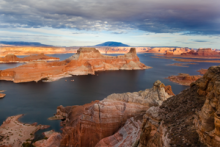Article
Lake Powell is a reservoir that was formed in 1963 with the construction of the Glen Canyon Dam and the flooding of the Colorado River. While located mainly in Utah, it also stretches across parts of Arizona. The creation of Lake Powell was both lauded and controversial. Water recreationists celebrated access to what would become the second-largest reservoir in the nation, with over 2,000 miles of lake-front access while those more interested in hiking bemoaned the loss of red slot canyons and back country wilderness. However, there was little public debate concerning the drowning of Native American sites. Ancient Puebloan structures and other artifacts and traditional cultural properties, sacred sites, and landscapes were destroyed in the deluge that formed the reservoir.
"Gunsight Butte, from Alstrom Point, Lake Powell, Utah, October 13, 2009" by Julie Edgley is licensed under CC BY-SA.
Manuscripts
References
Farmer, Jared
1999 Glen Canyon Dammed: Inventing Lake Powell and the Canyon Country. Tucson:
University of Arizona Press.
Linford, Laurance D.
2000 Navajo Places: History, Legend, Landscape. Salt Lake City: University of Utah Press.
United States Bureau of Reclamation
1965 Lake Powell: Jewel of the Colorado.
http://hdl.handle.net/2027/uiug.30112104107179, accessed March 3, 2016.

